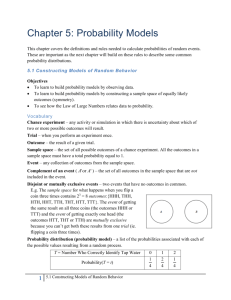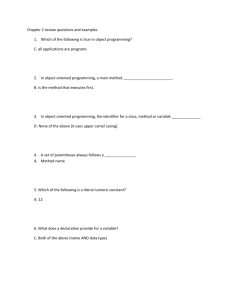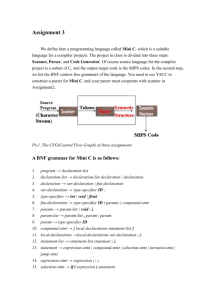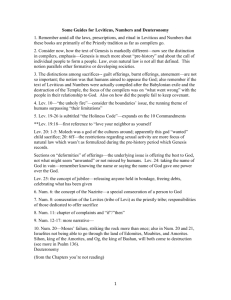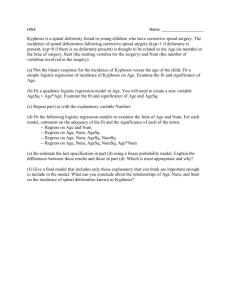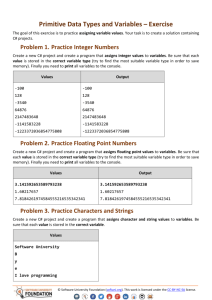Logic3eCh13 Solution..
advertisement
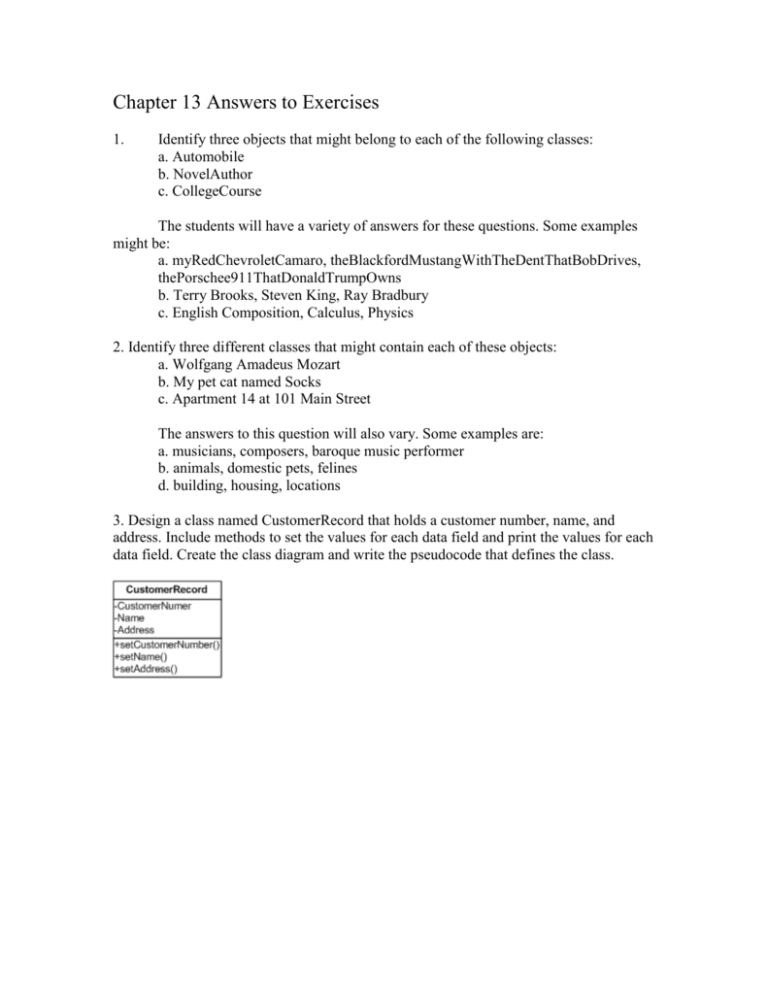
Chapter 13 Answers to Exercises 1. Identify three objects that might belong to each of the following classes: a. Automobile b. NovelAuthor c. CollegeCourse The students will have a variety of answers for these questions. Some examples might be: a. myRedChevroletCamaro, theBlackfordMustangWithTheDentThatBobDrives, thePorschee911ThatDonaldTrumpOwns b. Terry Brooks, Steven King, Ray Bradbury c. English Composition, Calculus, Physics 2. Identify three different classes that might contain each of these objects: a. Wolfgang Amadeus Mozart b. My pet cat named Socks c. Apartment 14 at 101 Main Street The answers to this question will also vary. Some examples are: a. musicians, composers, baroque music performer b. animals, domestic pets, felines d. building, housing, locations 3. Design a class named CustomerRecord that holds a customer number, name, and address. Include methods to set the values for each data field and print the values for each data field. Create the class diagram and write the pseudocode that defines the class. class CustomerRecord private num CustomerNumber private char Name private char Address public setCustomerNumber (num Number) CustomerNumber = Number return public setName (char newName) Name=newName return public setAddress (char newAddress) Address=newAddress return 4. Design a class named House that holds the street address, price, number of bedrooms, and number of baths in a House. Include methods to set the values for each data field. In the set methods, do not allow the price, bedrooms, or baths to be negative. Include a method that displays all the values for a House. Create the class diagram and write the pseudocode that defines the class. class House private char Address private num Price private num Bedrooms private num Baths public SetAddress(char newAddress) Address=newAddress return public SetPrice(num newPrice) if newPrice>0 then Price=newPrice endif return public SetBedrooms(num newRooms) if newRooms > 0 then Bedrooms=newRooms endif return public SetBathrooms(num newBaths) if newBaths > 0 then Baths=newBaths endif return public print() print Address, Price, Bedrooms, Baths return 5. Design a class named Loan that holds an account number, name of account holder, amount borrowed, term, and interest rate. Include methods to set values for each data field. In the set methods, do not allow the amount borrowed to be negative or over $100,000, the term to be over 30 years, or the interest rate to be over 17%. Also include a method that prints all the loan information. Create the class diagram and write the pseudocode that defines the class. class Loan private num AcctNumber private char Name private num Amount private num Term private num Rate public setAccoutNumber(num newNumber) AcctNumber = newNumber return public setName(char newName) Name = newName return public setAmount(num newAmount) if newAmount >= 0 and newAmount <= 100000 then Amount = newAmount endif return public setTerm(num newTerm) if newTerm <= 360 then Term=newTerm endif return public setRate(num newRate) if newRate>=0.0 and newRate <= 0.17 then Rate = newRate endif return public print() print AcctNumber, Name, Term, Amount, Rate * 100 return 6. Complete the following tasks: a. Design a class named Book that holds a stock number, author, title, price, and number of pages for a book. Include methods to set and print the values for each data field. Create the class diagram and write the pseudocode that defines the class. class Book private num StockNumber private char Author private char Title private num Price private num Pages public SetStockNumber (num newNumber) StockNumber = newNumber return public SetAuthor (char newAuthor) Author = newAuthor return public SetTitle (char newTitle) Title = newTitle return public SetPrice (num newPrice) Price = newPrice return public SetPages (num newPages) Pages = newPages return public print() print StockNumber, Author, Title, Price, Pages return b. Design a class named TextBook that is a child class of Book. Include a new data field for the grade level of the book. Override the Book class methods that set and print the data so that you accommodate the new grade-level field. Create the class diagram and write the pseudocode that defines the class. class TextBook descends from Book private num GradeLevel public SetGradeLevel(num newLevel) GradeLevel=newLevel return public print() print StockNumber, Author, Title, Price, Pages, GradeLevel return 7. Complete the following tasks: a. Design a class named Player that holds a player number and name for a sports team participant. Include methods to set the values for each data field and print the values for each data field. Create the class diagram and write the pseudocode that defines the class. Class Player private num Number private char Name public SetNumber(num newNumber) Number=newNumber return public SetName(char newName) Name=newName return public Print() print Number, Name return b. Design two classes named BaseballPlayer and BasketballPlayer that are child classes of Player. Include a new data field in each class for the player’s position. Include an additional field in the BaseballPlayer class for batting average. Include a new field in the BasketballPlayer class for free-throw percentage. Override the Player class methods that set and print the data so that you accommodate the new fields. Create the class diagram; then write the pseudocode that defines the class. class BaseballPlayer descends from Player private char Position private num BatAverage public SetPosition (char newPosition) Position = newPosition return public SetBatAverage(num newAverage) Average=newAverage return public Print() print Number, Name, Position, BatAverage return class BasketballPlayer descends from Player private char Position priave num FreeThrowPct public SetFreeThrowPct(num newFTPct) FreeThrowPct=newFTPct return public SetPosition (char newPosition) Position = newPosition return public Print() print Number, Name, Position, FreeThrowPct return 8. Complete the following tasks: a. Design a class named PlayingCard. Its attributes include suit (clubs, diamonds, hearts, or spades), value (a number 1 through 13), and valueName. If a PlayingCard’s value is between 2 and 10 inclusive, the valueName is blank; however, if the value is 1, the valueName is “Ace”, and if it is 11, 12, or 13, the value name is “Jack”, “Queen”, or “King”, respectively. Create two overloaded constructors for the class. One takes no arguments and uses a built-in method that returns a randomly generated number. This method’s signature is num rand (num high) where high represents the highest value the method might return—the method returns a random number between 0 and this high value inclusive. Use the random number generating method to select both the suit and the value for any PlayingCard that uses the default constructor. The second constructor method assigns values to the PlayingCard attributes based on passed arguments. This constructor verifies that the passed arguments are within range (that is, only one of the four allowed suits and only one of the 13 allowed values); if the values are out of range, force the PlayingCard to be the Ace of Spades. This nondefault constructor also sets the valueName for cards valued at 11 through 13. Also create a showCard() method for the class that displays a PlayingCard’s value. class PlayingCard private char suit private num value private char valueName private suitArray[4]=(“clubs”, “diamonds”, “hearts”, “spades”) public PlayingCard() declare variables newSuit=suitArray[rand(3) + 1] newValue=rand(12) + 1 suit=newSuit value=newValue perform setValueName() return public PlayingCard (char newSuit, num newValue) declare variables if newValue>=1 and newValue <=13 then value=newValue else value=1 endif perform setValueName() if newSuit = “clubs” or newSuit = “hearts” or newSuit = “spades” or newSuit = “diamonds” then suit = newSuit else suit = “spades” endif return public showCard() if valueName <> “” then print valueName, “ of ”, suit else print value, “ of “, suit endif return private setValueName() if value = 1 then valueName = “Ace” else if value >=2 and value <= 10 then valueName = “” else case based on value case 11 valueName = “Jack” case 12 valueName = “Queen” case 13 valueName = “King” default valueName = “Error, Not Possible” endcase endif endif return b. Design the logic for a program that instantiates two PlayingCard objects. Allow one object’s values to be randomly generated, but use user input values for the second object. start PlayingCard card1 getInput() PlayingCard card2(suit,value) card1.showCard() card2.showCard() stop getInput() do print “Pick a suit” print “1. clubs” print “2. diamonds” print “3. hearts” print “4. spades” read choice case based on choice case 1 suit = “clubs” case 2 suit = “diamonds” case 3 suit = “hearts” case 4 suit = “spades” default suit = “” endcase until suit <> “” do print “Enter a value” print “1. Ace” print “2 – 10 for number cards” print “11. Jack” print “12. Queen” print “13. King” read value until value >= 1 and value <= 13 return c. Add any additional class methods you need so that you can create a game in which the user tries to guess the value of a randomly generated PlayingCard. Give the user 1 point for guessing the suit correctly, 2 points for guessing the value correctly, and 10 points for guessing both values of the PlayingCard correctly. public makeGuess() do print “Pick a suit” print “1. clubs” print “2. diamonds” print “3. hearts” print “4. spades” read choice case based on choice case 1 testSuit = “clubs” case 2 testSuit = “diamonds” case 3 testSuit = “hearts” case 4 testSuit = “spades” default testSuit = “” endcase until testSuit <> “” do print “Enter a value” print “1. Ace” print “2 – 10 for number cards” print “11. Jack” print “12. Queen” print “13. King” read testValue until testValue >= 1 and testValue <= 13 return public scoreGuess() score = 0 if value = testValue then score = score + 2 endif if suit = testSuit then score = score + 1 endif if suit = testSuit and value = testValue then score = score + 1 endif return

